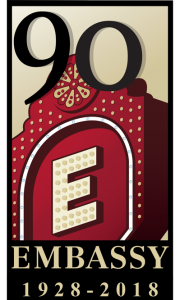Embassy Theatre Continues to Update Archives
The Fort Wayne (IN) Embassy Theatre’s ninetieth anniversary year, 2018, has been a busy one with a special show in May recreating the spectacle of the 1928 opening, release of three new CDs on its original and famous Grande Page organ, and a full schedule of stage shows,  concerts, films, visiting artists, and countless special events. But perhaps of greatest importance to members of the THS, the theatre’s efforts to preserve, catalogue, and display its important archive have advanced considerably since the project was first announced on the In-Studio blog last March.
concerts, films, visiting artists, and countless special events. But perhaps of greatest importance to members of the THS, the theatre’s efforts to preserve, catalogue, and display its important archive have advanced considerably since the project was first announced on the In-Studio blog last March.
The Embassy’s archive includes among many other things more than 600 photographs of performers who appeared at the theater and its sister, the Palace Theater, from the 1930s through the early 50s, ranging from some of the most famous bands and bandleaders to acrobats, animal acts, comedians, dancers, emcees, impressionists, instrumentalists, singers, ventriloquists, and so on. All of the pictures are signed and inscribed to the theatre’s long-time stage manager, Bud Berger. The archive also holds more than 300 posters, playbills, programs, stools, and even guitars signed by the stars and casts of shows that have played at the Embassy Theatre over the past forty years, ranging from classic and current Broadway shows to acrobatic groups, choral ensembles, dance shows, ballet, stand-up comedians, rock bands, country singers, travel films, silent films, theatre organists, and so on. Objects from these collections and other parts of the archive are on display in the Embassy’s new Heritage Room, which opened this year as part of the 90th anniversary celebrations.
than 300 posters, playbills, programs, stools, and even guitars signed by the stars and casts of shows that have played at the Embassy Theatre over the past forty years, ranging from classic and current Broadway shows to acrobatic groups, choral ensembles, dance shows, ballet, stand-up comedians, rock bands, country singers, travel films, silent films, theatre organists, and so on. Objects from these collections and other parts of the archive are on display in the Embassy’s new Heritage Room, which opened this year as part of the 90th anniversary celebrations.
In order to make these fascinating materials more widely known and accessible to theatre historians, aficionados, and the general public, excerpts from the catalogue for these collections are available for on-line viewing from links on the “Archives” page of Embassy’s web site. Each excerpt begins with a brief description of the collection and then includes the complete catalogue record for every object with the following fields:  Archive index number; Object (i.e., the category of material, such as “picture,” “playbill,” “poster,” “program,” “stool,” etc.); Name(s), if any or a description of the object; Date(s) if any; Dimensions and pagination as applicable; Description; and Picture.
Archive index number; Object (i.e., the category of material, such as “picture,” “playbill,” “poster,” “program,” “stool,” etc.); Name(s), if any or a description of the object; Date(s) if any; Dimensions and pagination as applicable; Description; and Picture.
The Embassy hopes you’ll enjoy browsing!
If you find this story fascinating, we have a treasure trove of information about the history of your favorite theatres. Sign up for an account on historictheatres.org and enter through the STAGE DOOR!
For nearly fifty years Theatre Historical Society of America has been celebrating, documenting, and promoting the architectural, cultural, and social relevance of America’s historic theaters. However, we can’t do it alone. Support from cinema lovers, architects, historians and people like you are paramount to our success. Become a member today, and help us preserve the rich history of America’s greatest theatres.
